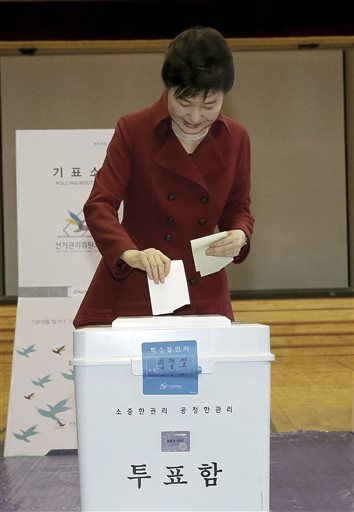
South Korean President Park Geun-hye casts her ballot for parliamentary elections at a polling station in Seoul, South Korea, Wednesday, April 13, 2016. South Koreans on Wednesday voted in the parliamentary election that many predict will hand President Park’s conservative party a decisive win, despite frustrations over a sluggish economy.
SEOUL, South Korea (AP) — President Park Geun-hye’s conservative party appeared headed for a surprising setback after South Koreans voted in parliamentary elections on Wednesday, with preliminary results strongly suggesting it would not regain its majority in the National Assembly.
The outcome would threaten Park’s plans to push ahead with controversial economic reforms, including plans to make it easier for companies to lay off workers, and blow open next year’s presidential race. The emergence of a new center-left party also ensures further changes to South Korea’s political landscape, which had long been shaped by just two parties.
Prior to the election, pollsters had predicted that the ruling Saenuri Party would crush a divided opposition and raise its expectations to take the presidency in 2017, after Park’s single term expires.
But just after midnight, with 73 percent of the votes counted, it looked almost certain that Saenuri would fail to achieve a majority in the 300-seat assembly.
Saenuri candidates were managing leads in 106 of the 253 areas producing regional representatives, trailing the main opposition Minjoo Party, whose candidates were front-runners in 108 areas. The People’s Party, a new party created mostly by those who left Minjoo, was leading in 26 areas.
The remaining 47 proportional representation seats will be allocated to parties according to the outcome of the party vote. Exit polls unveiled by television networks after the voting closed projected Saenuri to win 15 to 19 proportional seats.
There has been disappointment among South Koreans over a sluggish economy, with official figures showing household debt reaching new highs and the unemployment rate for people under 30 reaching levels not seen since the late 1990s, when millions lost their jobs during a crippling financial crisis. The preliminary vote counts indicate that the opposition parties have successfully absorbed conservative voters who have become disappointed with Park.
A weak showing by Saenuri would also indicate that voters weren’t swayed by national security issues as much as they were before, although surveys taken prior to Wednesday’s vote showed strong support for Park’s hard-line approach to North Korea following its recent nuclear test and long-range rocket launch.
Hostility between the rival Koreas in election years has often been seen as helping the conservatives by allowing them to highlight their hard-line approach against the North. Liberals have traditionally backed rapprochement policies with the North.
The National Election Commission estimated that 58 percent of the country’s 42 million voters participated in Wednesday’s election, a higher turnout than four years ago, when 54.2 percent of the electorate turned out. It wasn’t immediately clear whether larger participation by younger voters, seen as more likely to vote for liberals than voters over 50, contributed to the increase in turnout.
Minjoo was leading Saenuri in Seoul and the neighboring metropolitan area, where the two largest parties competed most fiercely. However, the People’s Party, led by Minjoo defector and likely presidential candidate Ahn Cheol-soo, was seen dominating Minjoo in its traditional strongholds in the southwest Jeolla regions.
Since losing its second consecutive presidential election in 2012, the Minjoo Party has struggled with factional infighting and lawmaker defections, and saw its seats decline from 127 to 102 in the current assembly.
South Korea’s electorate is deeply divided along generational and ideological lines, and also by fierce regional loyalties. Voters in the southeast Gyeongsang regions have for decades overwhelmingly voted for conservatives in parliamentary and presidential elections.















